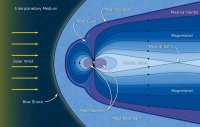Cluster explains nightside ion beams
6 December 2007
Understanding how solar material manages to reach the nightside of the Earth and flows back to Earth at high speeds is key to forecast the behaviour of the magnetic environment of the Earth and to protect space-based technologies. A recent study reveals for the first time that the tail of the magnetosphere is a place where ions can get highly accelerated simultaneously at different localized sites distributed along the tail axis. Nearly one hundred cases of such multiple high-speed ion beams were found over three years of data collected by the satellites of the European Space Agency Cluster mission. Altogether these observations fall in agreement with predictions of a theory published 14 years ago, that has recently been revisited.From the Sun to the nightside of the Earth
The Earth's magnetic field deflects most of the solar wind, a continuous flow of plasma expelled by the Sun. However, there are two regions located around the magnetic poles, known as polar cusps, where solar particles can precipitate along magnetic field lines towards the Earth magnetic poles (Animation 1 - step 1).
|
Animation 1. Origin of high-speed ion beams in the magnetotail. |
At each pole, a significant fraction of these particles bounces back along the magnetic field lines and populates the plasma mantle, a plasma layer located on the night side of the Earth, inside the magnetosphere along its boundary (Animation 1 - step 2). Under the action of electromagnetic forces, plasma contained in the mantle drifts equatorward, across the tail lobe and the plasma sheet boundary layer (PSBL) towards the current sheet region located along the tail axis (Image 1).
There, according to a model developed in the late 80's/early 90's, there exist a few localized regions in the current sheet called "resonant locations" (Animation 1 - step 3) where ions acquire kinetic energy along the magnetic field. The amount of energy acquired depends on how far in the tail the resonance location lies. Such accelerated ions are beamed back to Earth, from the magnetic equator, into the PSBL, towards the poles, in a kind of elongated parabolic flight along terrestrial magnetic field lines (Animation 1 - step 4). Satellite observations of these ion beams inside the PSBL allow predictions of this model to be tested.
High speed ion beams towards the Earth
 |
|
Image 2. Observation of "double-peaked'' ion distributions in the PSBL on 01.09.03. This plot displays the count of ions along the Earth magnetic field (HIA detector of the Cluster Ion Spectrometry instrument), onboard the Cluster satellite named Samba. |
A 14 years old theory backed by in-situ data
A theory published in 1993 by Professor Maha Ashour-Abdalla (UCLA, Los Angeles, USA), Dr. Berchem (UCLA), Dr. Buchner (Max Planck Institute, Berlin, Germany) and Prof. Zelenyi (IKI, Russian Academy of Sciences, Moscow), recently revisited (Zelenyi et al. 2006), predicted a universal scaling law for the velocity ratio of ion beams accelerated at distinct spatial sites in the magnetotail. The unique data set collected by the Cluster satellites allowed Professor Lev Zelenyi and co-workers to statistically check this scaling law.
"Each time, the ratio of velocities (V//1/V//2) of the two ion beams measured fell in agreement with the universal scaling law predicted by Prof. Ashour-Abdalla and co-workers in 1993," wrote Zelenyi in a study published in Geophysical Research Letters in 2006.
A recent study published in the Journal of Geophysical Research in May 2007 focuses on the spatio-temporal characteristics of these ion beams or beamlets to estimate their typical duration and size in the direction perpendicular to the equatorial plane (Z-axis). Previous studies based on single satellite missions reported typical beamlet duration ~1-2 minutes and no scale size could be inferred.
"Our statistical studies based on simultaneous observations by three satellites of the Cluster mission show for the first time that the typical beamlet duration is ~5-15 minutes and its typical spatial extent in the Z-direction is ~1300-4500 km. Cluster observations have led to a new understanding of this phenomenon," says Dr. Elena Grigorenko (IKI, Russia) lead author of this study.
Thanks to ESA's long term commitment
"The long term commitment of the European Space Agency to the Cluster mission is key to achieving such scientific highlights: accumulating data over the years to bridge observations with theory, the only way to enhance our knowledge of the highly dynamic magnetotail region," says Philippe Escoubet, Cluster and Double Star project scientist of the European Space Agency.
References
Grigorenko, E.E., J.-A. Sauvaud, L.M. Zelenyi, Spatial Temporal characteristics of ion beamlets in the plasma sheet boundary layer of magnetotail, J. Geophys. Res., Vol. 112, No. A5, A05218, http://dx.doi.org/10.1029/2006JA011986, 24 May 2007
Zelenyi, L.M., M.S. Dolgonosov, E.E. Grigorenko and J.-A. Sauvaud, Universal properties of the nonadiabatic acceleration of ions in current sheets, JETP Letters, 85, 4, 187-193, 2007
Zelenyi, L.M., E.E. Grigorenko, J.-A. Sauvaud, R. Maggiolo, Multiplet structure of acceleration processes in the distant magnetotail, Geophys. Res. Lett., 33, L06105, doi:10.1029/2005GL024901, 2006
Related articles
Ashour-Abdalla, M., J. P. Berchem, J. Buchner, and L. M. Zelenyi, Shaping of the magnetotail from the mantle: Global and local structuring, J. Geophys. Res., 98, 5651, 1993
Zelenyi, L.M., M.S. Dolgonosov, V. Peroomian, M. Ashour-Abdalla, Effects of nonlinearity on the structure of PSBL beamlets, Geophys. Res. Lett., 33, 18, L18103, doi:10.1029/2006GL026176, 2006
Contact
Main author
Lev Zelenyi, IKI Space Research Institute, Russian Academy of Sciences,
Moscow, Russia
E-mail: lzelenyi iki.rssi.ru
iki.rssi.ru
Phone: +7(495) 333-52-12
Web story author and co-editor
Arnaud Masson, Science Directorate, ESA, The Netherlands
E-mail: Arnaud.Masson esa.int
esa.int
Phone: +31-71-565-5634
Web story co-editors
Philippe Escoubet, Science Directorate, ESA, The Netherlands
E-mail: Philippe.Escoubet esa.int
esa.int
Phone: +31-71-565-4564
Matt Taylor, Science Directorate, ESA, The Netherlands
E-mail: Matthew.Taylor esa.int
esa.int
Phone: +31-71-565-8009



